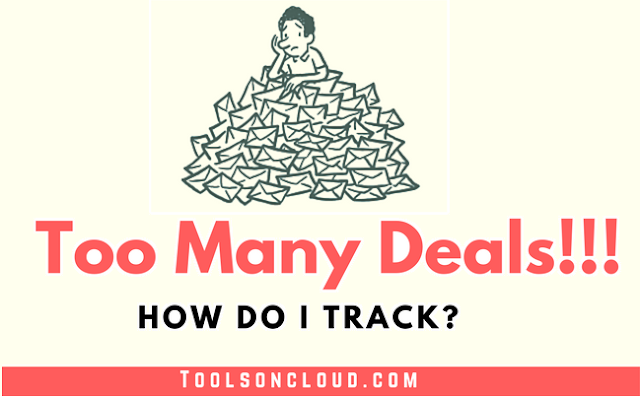While dealing with multiple activities associated with a sales process like Prospecting, Suspecting, Meeting, Closing, etc, you might have come across a situation where you have a lot of sales deals in your pipeline. A few of these deals would be in their initial stages while a few would be somewhere in the middle of the sales process which is just about to complete.
When you are handling lots of in-progress deals, it's hard to remember all. At this point of time, you would need a tool to track your Sales Deals or Leads. Beginners, usually start with Excel or any Spreadsheet application like Google Sheets.
 |
| Too Many Deals!!! How Do I Track? |
If you are in this situation, then you must know 7 Important Data Fields which you must record in your Sales Lead Tracker in order to effectively organize and manage your Sales Lead Database later. The 7 Data fields are:
1. Client's Company Name
This is an obvious but important field you must enter in your Sales Tracking database. It is important to make an entry of Company Name because the deal on which you are working might not be the last one for this company. You may expect to get more and more deals from the same company later as well. In this case, if you make an entry of company name, in the future you will be able to look at all the past deals done with the company by just using a filter or sort option in Excel.
2. Point of Contact (PoC)
In this field, you must enter the Name and Contact Information of the person whom you have approached or would be contacting in future with regards to this deal. The contact information can be either Email Id, Phone Number, Linkedin Id, etc whichever is applicable for your business situation.
3. Expected Deal Value
You must necessarily note down the expected deal value or deal size while tracking leads. This can be done at any stage of the sales process but better get it done in the Lead Qualification stage itself. This data field would help you prioritize your sales efforts against each of the Leads. Being a salesperson, time is the biggest constraint you have to deal with. With this limited time, you should focus more of your time on High-value deals rather than wasting time on Low-value deals which may or may not convert later.
Remember! If the prospect is serious, they would be having a Pre-determined Budget, thus they should be able to tell you the deal size provided you enquire for it.
4. Contact Logs
This is an important data field to build a long-term relationship with the Prospect. You must note down all the important contact logs which include important conversations you had with the prospect organized in chronological order. This field must give information on the follow-up calls or meetings you had with the prospect and the outcomes of the calls. Building this data helps you build a long-term relationship with your prospect since you would be in continuous contact with the prospect and would be having a clear idea of his expectations. Having a good contact log entry would also equip your fellow sales team members to handle the sales calls in your absence.
5. Next Followup date
Recording the Next follow-up date after every interaction with the client would help you plan your activities in advance. Regular follow-up with the Client at the right time is extremely important for converting the deal. Many deals are usually lost just because the salesperson missed to follow up with the client before the deadline or date agreed upon by the Client.
6. Date of Entry
This might look obvious but many Salespersons usually miss out on recording the date when the prospect was first established. This is an extremely important parameter that you must track because it would tell you, how far you have come up with a deal and how many more days do you require to close that deal. With this, you can compare whether the Deal Duration is more than your average Deal Duration or less. This would help you make better decisions on whether or not to pursue the deals which are dragging too much while consuming more of your efforts.
7. Probability of Winning the Deal
You can enter this parameter in terms of percentage which gives the probability or chances of the deal getting converted. Though this is a subjective parameter that no one can predict accurately, you should still make a record of this field.
You can still Objectify this subjective parameter by putting up categories instead of pure numbers. For. E.g. you can make 5 categories like
- Highly Likely (90% Probability)
- Likely (75% Probability)
- Neutral (50% Probability)
- Less Likely (25% Probability)
- Least Likely (5% Probability)
and then you can assign some percentage score (the way I have assigned above) to each of the categories using your instincts as applicable for your business environment.
This data field would help you the most in organizing your efforts so that you focus more on the deals with Higher Deal Value and Higher Probability in order to Sell More and achieve your quotas faster.
I hope you liked the post! Do let me know your thoughts on this.
Check out our other articles on the blog.
Looking for Sales CRM to organize your sales? Try Toolsoncloud CRM, It's Free.

0 comments: